The strength of the Tata Motors-Jaguar Land Rover combination was best embodied by the 2019 Harrier and later the Safari, two big built sports utility vehicles which were developed on the Omegarc, an architecture that is derived from the Land Rover D8 platform. The Tata Harrier is barely four years old and yet has already witnessed much action within “TaMo’s” portfolio. Added features, and multiple special editions enabled Tata Motors to finetune the positioning of the Harrier, in what has arguably been one of the fastest growing segments in the passenger car market.

The Harrier has just been given the most comprehensive update and facelift since its birth. In fact, the facelift is so significant, that while one can see that it is still the same essential blueprint as the outgoing model, it doesn’t quite look the same from the front, the rear or in the cabin. The first impression when I look at the new Harrier is that some of the remaining raw edges of its design have been cleaned up nicely, and there is a perceptible sense of premiumness now. The Harrier is a large SUV and the aggressive, over sporty face of the pre-facelift model, has given way to a ‘suaver’ front profile. The facelift has focused on better integration of metal and plastic panels, and other exterior components. The surfacing and joints are much improved even though the body panels are all identical to the outgoing model.
At the front, the 2024 Harrier gets a brand new bonnet grille with a layered, morse code-like slatted design. The clamshell-style bonnet’s edge line runs parallel to the slim LED DRLs, which in this new avatar are connected by an LED bar in the middle much like in the new Nexon. The front fender features a horizontal midsection cut that almost mirrors the two halves with the grille on the top and a large airdam at the bottom. The main LED headlamps and fog lamps are positioned at the top of a sort of triangular crevice on either side that also sport air-curtains which are both aesthetic and functional. The side profile of the new Harrier is almost identical to the outgoing model except for the new R18 alloy wheels with aero inserts. The 2024 Harrier Black Edition is also being launched simultaneously and it gets the 19-inch alloys.
One of the other changes that Tata Motors has adopted from the rollout of the new Nexon is the ‘Persona’ nomenclature for the trim variants. The previous alpha-numeric variants have given way to Smart, Pure, Adventure and Fearless. These four basic variants come with optional and plus packs that add more features and design differentiators to the mix. Three of these variants are offered as Dark Editions. The Persona variants have been kitted out based on market research about the likely preferences of each of the types of buyers they target, say Tata officials. While the personas themselves don’t find mention in the form of badges, there is some additional branding on the body panels and the tailgate for the new Harrier.
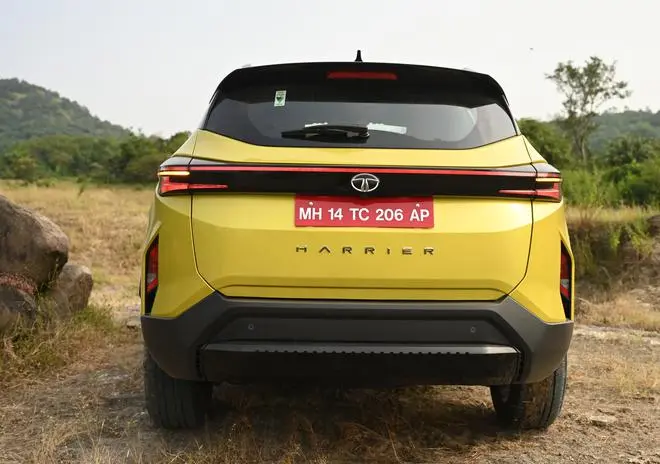
At the rear, the new Harrier gets changes to the tail lamps with the addition of a new swoosh-style LED tube that adds more character to the brake lights | Photo Credit: BIJOY GHOSH
At the rear, the new Harrier gets changes to the tail lamps with the addition of a new swoosh-style LED tube that adds more character to the brake lights. There is also the addition of a connecting LED strip between the two tail lamps that enhances the perception of width. The rear fender is also all-new with a chunky faux underguard. There are few new Easter eggs on the rear glass, bold lettered Harrier branding on the tailgate. And the loading lip of the tailgate is low. The automatic tailgate in my Fearless persona variant also gets easy gesture-based opening (just a wave of my leg under the rear fender) in case your hands are occupied with shopping bags.
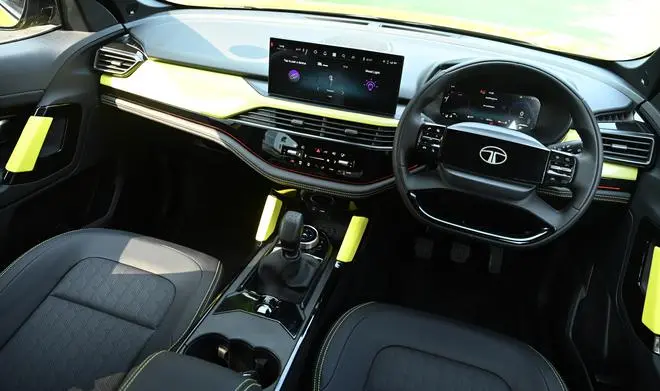
The interior gets a colour-coordinated trim strategy that brings in the body colour into some of the cabin elements | Photo Credit: BIJOY GHOSH
Cabin
The new Harrier gets a set of new paint finishes including this yellow that you see in these pictures. It is not as yellow in the flesh, but surprisingly the body colour sits well on the Harrier and Tata officials tell me that the paint process has been given an upgrade to get this improved finish quality. Like in the new Nexon, the big change in the Harrier is inside the cabin. The focus has been digitisation and elevating the cabin quality. The first element to catch my eye is the steering boss with its black screen and backlit Tata logo coming on when I punch the start button. The interior gets a colour-coordinated trim strategy that brings in the body colour into some of the cabin elements. While the checked, textured yellow dashboard panel looks good and is not too garish, the yellow faux leather door grab handles are bit too bright for my liking; maybe some buyers will be ‘Fearless’ like the Harrier persona I was driving.
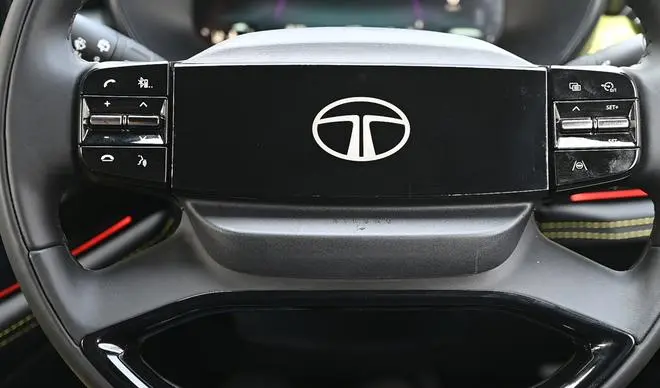
The first element to catch my eye is the steering boss with its black screen and backlit Tata logo coming on when I punch the start button | Photo Credit: BIJOY GHOSH
The persona themed cabins gets dual colour themes and a varying mix of features and elements. My test mule sported ambient mood lighting including for the sunroof, a new central control touch panel for the aircon on the centre stack, the new 31.24cm Harman touchscreen infotainment screen and a new 26.03cm digital instrument cluster. With almost four screens staring back at you, the cabin truly feels more modern and up-to-date. In my test mule, the music system is a 10-speaker JBL unit that is controlled via Harman Audioworx and multiple preset modes selectable on the infotainment screen. The music system’s reproduction is good with rich vocals and strong bass. The infotainment screen is much bigger than the outgoing model’s unit and there is a lot many more options to choose from and from a menu that has been created for intuitive use and with crisp detail.
There’s wireless Apple CarPlay and Android Auto, and there is also Alexa integration for better connectivity and remote connected features. The sunroof is also voice-activated. The overall impact of the cabin has been elevated with the use of materials like stitched leatherette for dashboard base trim elements, the seats are now better bolstered and get ventilation. The front two seats also get 6-way electric adjustment, and the driver’s seat gets memory functions too. The 360-degree camera output is clear and hi-res, with multiple angles and a choice of 2D or 3D display styles finding your way into tight parking spots will be a breeze. There is the addition of a new mode selector on the centre console which allows one to choose between highway, wet and off-road terrain modes. However, the Harrier is still not an all-wheel drive vehicle.

The boot offers 445 litres of storage space. And the overall space in the cabin is good. The new 4-spoke steering wheel is unique to the Harrier and bigger sibling Safari, and the dual tone finish and the flat bottom finish is great. The new lever for the auto gearbox (in my test mule) is also nicely finished with a luxury car style build. Overall, there is a huge jump in the perceived quality of the cabin. Yet, there are a few small niggling ergonomics issues with the new Harrier’s cabin. The footwell for the driver should have had a concave panel above to allow for drivers with shoes to operate the brake pedal without brushing against it (on the panel above). The wireless phone charger has been positioned too deep into the centre console and there are a few fiddly levers and controls. Oversized headrests for the rear seats are good to use but restrict rear view for the driver.
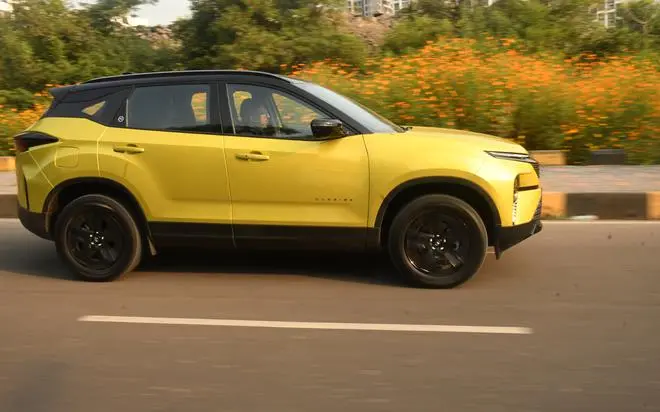
Performance
The new Harrier continues to get the same 2-litre diesel engine from the outgoing model. That is still the only engine option currently, with the petrol mill only expected by the end of 2024. This Kryotec 170 4-cylinder engine is a 1,956cc turbocharged oil burner that is now BS6 Phase 2 compliant. The engine has been carried over in the same state of tune and delivers 170PS of peak power and 350Nm of torque. The engine continues to be offered with either a 6-speed manual transmission or a 6-speed automatic. The diesel engine is an adequately powerful unit and in terms of driveability continues to feel like the previous model.
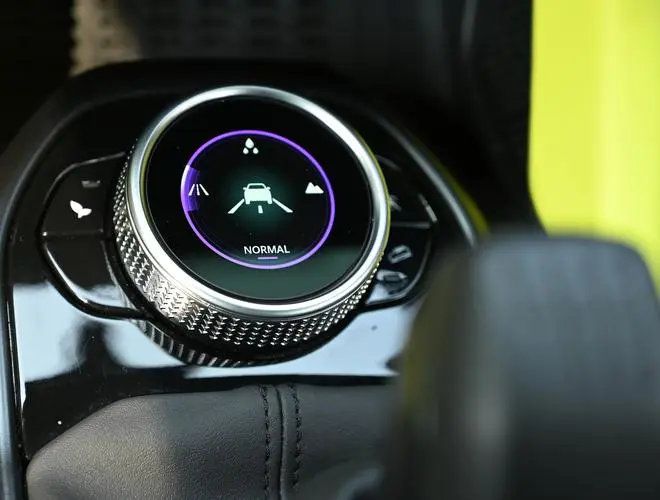
There are few changes to the ratios, but the strong mid-range performance character of the engine is the same. It is a raucous engine and though much of the noise has been cut away from the cabin at low engine speeds, there is quite a bit that seeps in during mid-cycle which rises up quickly as I accelerate harder. The shifts on the manual gearbox are better, and there is no torque steer, but using the long travel clutch pedal will take a bit of getting used to.
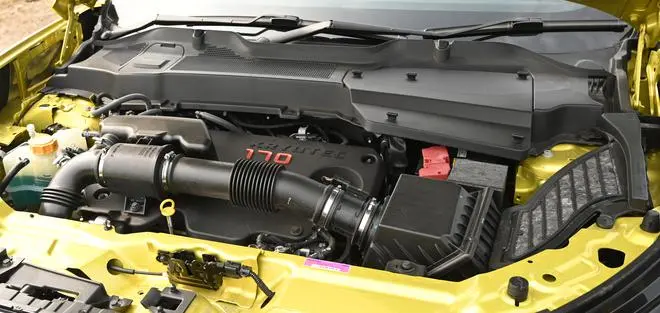
The terrain modes modulate the ESC characteristics to aid in better stability under different conditions. In addition, the new Harrier also gets three drive modes — Eco, City and Sport, and predictably throttle response is most agile in Sport mode. The big change in ride and handling for the new Harrier is the replacement of the old hydraulic steering with a new electric power steering which is lighter, easier to use in the city, weighs up a bit on the highway and is much more accurate than the outgoing model’s hydraulic set up. The steering also gets a sports mode. The big impact on me during the drive was this new electric power steering. The ride is also better, thanks to some suspension tweaks and the slightly wider track from the new tyres. The additional contact patch offers better grip and more stability into corners. Overall suspension performance is better, though it wasn’t in need of much change.

Bottom Line
The new Harrier continues to be built on a platform that has scored high on safety tests. It gets six airbags (seven for top spec), traction control, tyre pressure monitoring, and ESC as part of standard fitment. Some of the top spec persona variants get 12 ADAS functions and features using cameras and radars, one each at the front and rear. The auto speed limit recognition was a useful function, as so was the lane departure warning. In fact, the other point I liked was the way the warnings were audible though not annoying or loud. Another plus for our driving conditions will be the blind spot assist with a real-time camera feed on the infotainment screen.
The new Harrier has been positioned at starting ex-showroom price of ₹15.49 lakh for the base variant and goes up to ₹24.5 lakh for the top spec Fearless+.






Comments
Comments have to be in English, and in full sentences. They cannot be abusive or personal. Please abide by our community guidelines for posting your comments.
We have migrated to a new commenting platform. If you are already a registered user of TheHindu Businessline and logged in, you may continue to engage with our articles. If you do not have an account please register and login to post comments. Users can access their older comments by logging into their accounts on Vuukle.